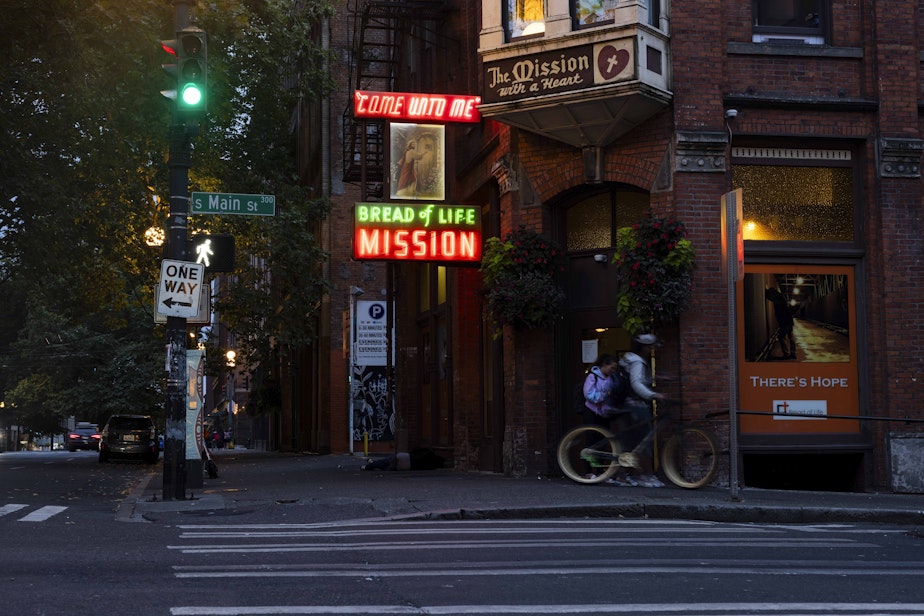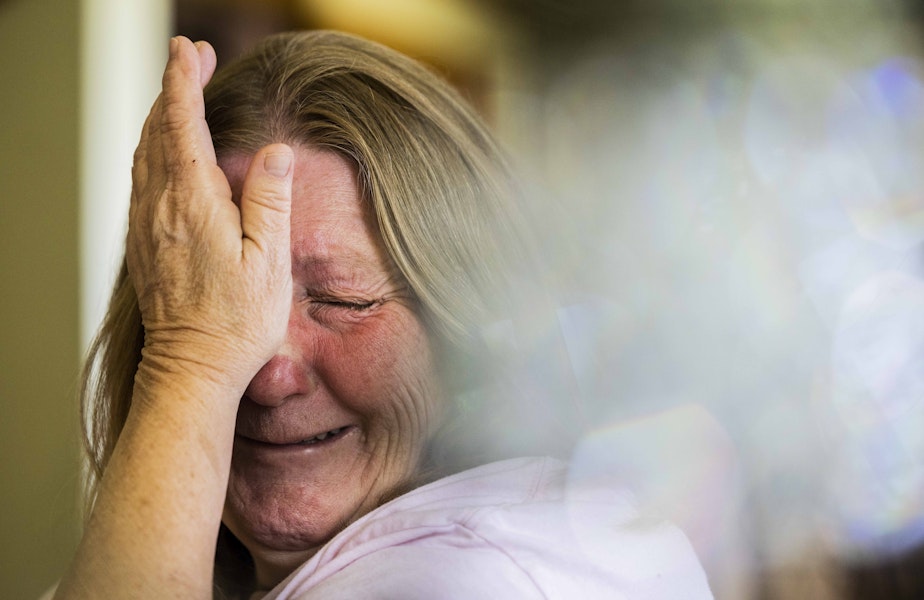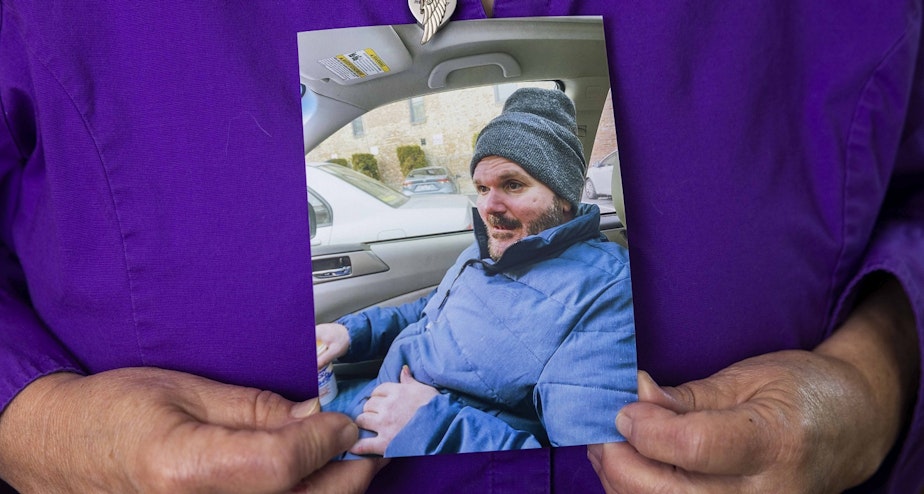Vulnerable patients caught in ‘churn’ between Washington mental health care systems face life and death circumstances

I
t was January 2023, and her son, Adam, was about to be released from Western State Hospital in Lakewood, Washington, southwest of Tacoma. Heidi Aurand knew he wasn’t ready to be on his own. Adam was not in a good place.
For several weeks, doctors had been weaning him off his medications. Aurand and her daughter, Bethany Anderson, saw signs that Adam was backsliding.
“The voice got darker, and the little whispers started again,” Anderson said. “The smart comments, the really crude behavior, you could hear it in him.”
Sponsored
When Adam was suffering from schizophrenia, he believe a light inside himself could heal people. As his release date approached, Heidi Aurand asked her son, who had refused to wait until housing could be found for him, how he would stay warm in Seattle when he was released in February.
“The light will keep me warm,” Adam told her.
RELATED: A boy named Adam: When psychosis spills onto Seattle streets
Aurand reached out to hospital staff in hopes that her son’s release could be delayed. She told them Adam was hearing voices and talking about the light again.
“I was frantic,” she said. “I didn’t know what to do.”
Sponsored

The email she got back from the hospital said basically, “Thanks for letting us know. He is going to be discharged next week.”
Adam’s discharge and what happened to him once he was back on Seattle streets illustrate a troubling gap in the mental health system, especially when it comes to people suffering from severe mental illness. After patients are released from psychiatric hospitals, where do they go and who takes care of them?
That question and the lack of an adequate answer continues to haunt Adam’s family. Like many people who suffer from both mental illness and drug addiction, Adam had spent almost a decade in the “churn,” richocheting between emergency rooms, psychiatric hospitals, jails, prison, and life on the streets in and around Seattle.
Sponsored
Signs of Life
H
eidi Aurand hadn’t heard from her son for six months when she received a Mother’s Day card in her mailbox in 2022. The return address: Western State Hospital.
Heidi and her daughter were relieved. Adam was alive. If he was in a psychiatric hospital, that meant he was being taken care of and likely taking medications to curtail his schizophrenia.
Western State is one of two psychiatric hospitals in Washington state. With 800 beds, it is one of the 10 biggest psychiatric hospitals in the U.S. The state’s second biggest mental health institution is a prison with a 500-bed psychiatric unit.
Sponsored
The connection points to the blurring of lines between criminal justice and mental health in the U.S. Most of the people who end up at Western State come from jail.
RELATED: His mom worried he’d wind up dead. But getting him committed was nearly impossible
Adam fit this profile. He had served a three-year sentence for car theft and was released from prison into homelessness at the height of the pandemic. Less than a year later, he showed up in criminal records again, arrested in 2022 for throwing an empty beer can at a police officer.
He was deemed too mentally ill to stand trial and began a second stint in jail, waiting for a bed in a psychiatric hospital to become available.
In 2022, 2,000 people in Washington state were deemed too mentally ill to stand trial. Some go to a state psychiatric hospital for “competency restoration,” giving them just enough treatment to allow them to participate in his own criminal case.
Sponsored
Others, like Adam, are deemed to need significant treatment. In those cases, charges are often dropped, and patients are moved to a different part of the hospital for a longer-term stay.

After Adam was stabilized and put on medications, Heidi and Bethany started to see his old personality emerge. He was the Adam they both remembered, someone who could remodel a car, teach himself a musical instrument, or train a dog without the use of treats. They thought he was finally on the path back to a stable, functional life.
Released From Care
A
dam had been at Western State for the better part of a year, when his mom and sister learned he was going to be discharged.
Because Adam was at Western State as a civil patient, under the state’s Involuntary Treatment Act, every 90 to 180 days the hospital had to go to court and make a case that he remained either a danger to himself or to others.
Aaron Goddu, who oversees the discharge process for Western State and other state institutions in Washington, leads a team of social workers who try to place discharged patients.
Goddu said he could not talk specifically about Adam’s care, but he said the state law is clear when it comes to civil patients.
“If they're no longer requiring active treatment, it's unethical for us to continue to keep them detained at a facility for any longer than they should be,” Goddu said.
Goddu said it’s also very challenging for hospital staff to distinguish between drug-induced psychosis and mental conditions like schizophrenia.
RELATED: 50 years ago, many psychiatric hospitals closed. Did that cause today's mental health crisis?
In Adam’s case, the discharge paperwork listed substance use disorders, but included no actual diagnosis for a mental health disorder. That’s despite the diagnoses Adam got previously from doctors in prison and elsewhere, his erratic behavior, hearing voices, believing he had a healing light inside himself, and the repeated warnings from family members.
Without that paperwork, the state decided they had no legal grounds to continuing holding Adam against his will. They tried to get him to continue staying at Western State voluntarily until hospital staff could find him housing, but Adam refused. He wanted out.
Challenges of Placement
W
estern State has a team of about eight social workers whose job it is to line up housing and follow-up care for patients like Adam. But the options are often limited. Group homes in and around Seattle have closed in recent years because of reduced governmental support and because Medicaid pays so little for patients with serious mental illness.
What’s left is supportive housing, enhanced services facilities, adult family homes, and a few remaining group homes. Each of those facilities has its own criteria, its own specialties, and its own rules about who gets in and who doesn’t.
“Our social workers are cold calling and sweet talking and trying to do whatever we can to kind of wheel and deal,” Goddu said.
Even when a spot is found, the discharged patient often has to go through an interview with the facility about the rules and requirements of living in that space.
“It can be challenging,” Goddu said.
In Adam’s case, he had actually been offered a spot in a halfway house, but turned it down. Social workers asked his mother and sister if they could take Adam in, but neither felt they had the resources or expertise to take care of him without help.
“I don’t know anything about mental illness. I don’t know how to deal with it,” Aurand said. “My meaning maybe was not clear, but my meaning was, I need help with that. I can’t do that on my own.”
Return to Homelessness
W
hen Aurand realized her son was going to go from Western State to living at a homeless shelter, she tried to do what she could to prepare him. She made calls to try to set up Social Security disability benefits. Adam has a lifelong disability due to brittle bone disease.
But Aurand, who lives in Portland, Oregon, found that she could do very little to put Adam in a position to succeed and survive after his release. It would be up to Adam to resume Social Security and Medicaid benefits after his release.
In terms of housing, it was impossible to guarantee that Adam would have a place to live in a homeless shelter in Downtown Seattle after his release.
“In-patient psychiatric care does not align with our homeless services system,” Goddu said. “We’re getting in line just like everybody else.”
Adam was released on Feb. 7, 2023. His mother said she was told he was driven downtown and dropped off with his ID, $40, 30 days of medication, a prescription, and a 1-800 number for King County’s crisis hotline. He was supposed to check in to the Bread of Life Mission, but it’s not clear that he ever made it there.
RELATED: Who was Lillian Massey? A journey to Northern State psychiatric hospital
Aurand stopped hearing from her son. She searched for him on street cameras and eventually found him near a fountain popular with homeless people and drug users in Downtown Seattle. She drove up and found him, but she couldn’t get him to either come home with her or go to housing elsewhere.
“I tried to talk to him,” Aurand recalled. “He was talking to himself. I said, ‘Did you do drugs today?’ and he says, ‘I smoked something out of a pipe.’”
Aurand took Adam to a hotel but the next day, she couldn’t get him to go home with her or to seek help from a Seattle hospital. So, she took him to breakfast and then, when he threatened to jump out of the car, she stopped and let him go. She called the crisis line and then police, who said they would check up on her son.
The Final Call
O
n March 6, 2023, Aurand got the call that her son Adam had been found unconscious and unresponsive in the Belltown neighborhood of Seattle. He had overdosed on meth and fentanyl.
It was only after Adam died that his mother and sister were able to access his records and treatment and really chart the course of his life through different hospitals, jails, and prison — almost a decade in the “churn.”
Aurand can’t help but blame the gaps in the system that her son fell through, despite his obvious mental illness and his continued need for care that was suddenly cut off, just when he was finally getting better.
“I’m sorry but those people at Western might as well put a bullet in his head when he walked out that door,” she said, “because they killed him.”
To listen to the full episode of “Lost Patients,” tap the link above.
Looking for mental health resources? KUOW compiled an "Acute mental health resource guide" that can help.




